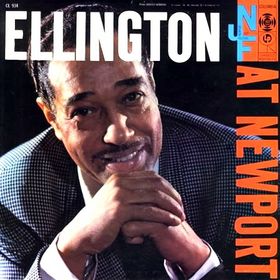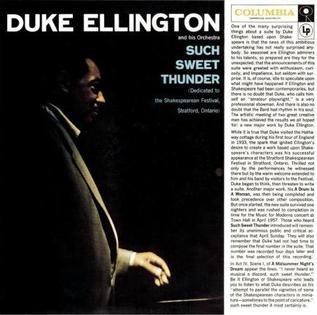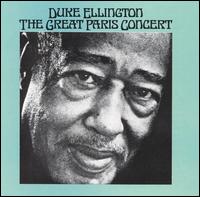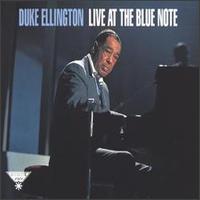
Paul Gonsalves was an American jazz tenor saxophonist best known for his association with Duke Ellington. At the 1956 Newport Jazz Festival, Gonsalves played a 27-chorus solo in the middle of Ellington's "Diminuendo and Crescendo in Blue," a performance credited with revitalizing Ellington's waning career in the 1950s.

Ellington at Newport is a 1956 live jazz album by Duke Ellington and his band of their 1956 concert at the Newport Jazz Festival, a concert which revitalized Ellington's flagging career. Jazz promoter George Wein describes the 1956 concert as "the greatest performance of [Ellington's] career... It stood for everything that jazz had been and could be." It is included in the book 1001 Albums You Must Hear Before You Die, which ranks it "one of the most famous... in jazz history". The original release was partly recreated in the studio after the Ellington Orchestra's festival appearance.

Russell Keith Procope was an American clarinetist and alto saxophonist who was a member of the Duke Ellington orchestra.

Ellington Indigos is a 1958 jazz album by Duke Ellington.

The Blanton–Webster Band is a compilation album that combines the master takes of all the recordings by Duke Ellington's Orchestra during the years of 1940 to 1942, involving bassist Jimmy Blanton and tenor saxophonist Ben Webster. The recordings were originally made for RCA Victor during what many critics regard as the Ellington orchestra's golden period. The three CDs contain many numbers which were to become classics, and the arrangements were frequently inventive and innovative.

Tell It the Way It Is! is an album recorded in 1963 by saxophonist Paul Gonsalves. He is joined by Johnny Hodges and Ray Nance, both members of the Duke Ellington Orchestra, pianist Walter Bishop Jr., and trumpeter Rolf Ericson.

Such Sweet Thunder is a Duke Ellington album, released in 1957. The record is a twelve-part suite based on the work of William Shakespeare.

The Great Paris Concert is a 1973 live double album by jazz pianist Duke Ellington preserving pieces of a series of performances given in Paris during February 1963, a decade prior the release. For the 1989 CD reissue, 10 additional recordings from the same series of Paris concerts were added to the release. These 10 performances had previously been released on the 1967 LP Duke Ellington's Greatest Hits: Recorded "Live" In Concert.
Sacred Concert by Duke Ellington is one of the following realisations:

Changes Two is an album by Charles Mingus. It was recorded on 27, 28, and 30 December 1974 at Atlantic Studios in New York City—the same sessions which resulted in Mingus's album Changes One. Atlantic Records initially released the record; in 1993, it was issued on CD by Rhino Records.

Blue Rose is the debut studio album by Rosemary Clooney, in collaboration with Duke Ellington and his orchestra, released in mono on Columbia Records, catalogue CL 872. Although she had appeared on albums before, it had been in the context of either a musical theater or multiple artist recording. The album also marked the return of Ellington to Columbia after an absence of four years, and was one of the first examples of overdubbing being used as an integral part of the creation, rather than for effects or to correct mistakes.

Duke Ellington at the Bal Masque is an album by American pianist, composer and bandleader Duke Ellington recorded in 1958 and released on the Columbia label.

Blues in Orbit is an album by American pianist, composer and bandleader Duke Ellington recorded for the Columbia label in 1959 and released in 1960.

Live at the Blue Note is a live album by American pianist, composer and bandleader Duke Ellington recorded at The Blue Note nightclub in Chicago for the Roulette label in 1959.

Ellington '55 is an album by American pianist, composer and bandleader Duke Ellington recorded for the Capitol label in 1953 and 1954 and released in 1955. The album features the Ellington Orchestra's performances of popular big band compositions and was reissued on CD with two bonus tracks in 1999.

Masterpieces by Ellington is the first LP album by American pianist, composer, and bandleader Duke Ellington, recorded for the Columbia label in 1950. It was one of the earliest 12-inch LPs to take advantage of the extended time available and consisted of four tracks, three of them "concert arrangements" of Ellington standards and one, "The Tattooed Bride," a recent tone poem.

Featuring Paul Gonsalves is an album by American jazz pianist, composer, and bandleader Duke Ellington. Without new material to work with, Ellington recorded the album with his orchestra and saxophonist Paul Gonsalves in 1962 during a four-hour recording session. It was not released until 1985 by Fantasy Records.

Back to the Tracks is a hard bop album by tenor saxophonist Tina Brooks recorded in 1960 and released posthumously. The album was originally intended as BLP 4052, but, for some reason, it was shelved at the time. A song recorded during the session, "David the King", was rejected since it "never made it to releasable quality". The composition was later re-recorded for Brooks' final Blue Note session, eventually released as The Waiting Game. The tracks first appeared in a Mosaic 12" LP box-set (MR4-106) entitled The Complete Blue Note Recordings of The Tina Brooks Quintets. A Blue Note CD appeared in 1998, then reissued in 2006.

Jingle Bell Jazz is a collection of jazz versions of Christmas songs recorded between 1959 and 1962 by some of the most popular artists on the Columbia label. It was released on October 17, 1962.

Duke with a Difference is an album by American jazz trumpeter Clark Terry featuring tracks recorded in 1957 for the Riverside label.



















